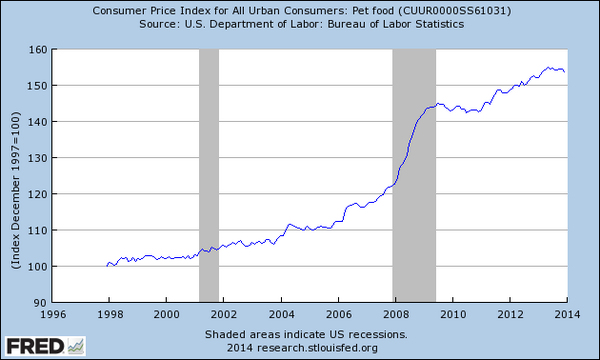From 2007 to 2011, spending on pets stayed close to 1 percent of total expenditures per household, despite the recession that occurred during this time. Spending on pet food stayed constant or increased during the recession, even while spending at restaurants fell.OR DID IT??
The chart below (from BLS) the average yearly spending on Pet Food (Left Axis) and "food away from home"(Right Axis). The yellow area represents the time span of the recession (Dec 2007 to June 2009)
It appears spending on our pets dietary needs stayed relatively constant throughout the recession, whereas spending on meals away from home took a nosedive. One could conclude that the income elasticity of demand for pet food is relatively INELASTIC (quantity demanded did not change much relative to the decrease in income during the recession) and the income elasticity of demand for meals away from home is relatively ELASTIC (quantity demanded changed A LOT relative to the decrease in income during the recession). In other words, people did not buy less pet food but bought fewer meals out of the house.
But is this TRUE??
 |
| Source: Bureau of Labor Statistics |
The chart above does not say it adjusts for inflation. So, it is possible (likely) that the quantity of pet food purchased DID actually decrease but the higher price for the smaller quantity makes it appear that the same amount of pet food was sold. The numbers in the chart are nominal. To adjust for inflation to find the real value we would have to know the quantity of pet food.
I think it is safe to say that Americans bought less of BOTH goods during the recession.
Do I have it right???

No comments:
Post a Comment